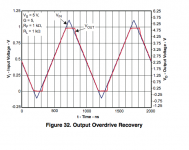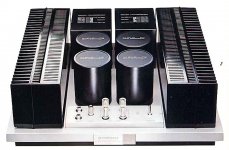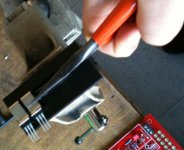The time of high end audio is long gone. Levinson the man said that to me in the 80th.
Original Mark Levinson and Threshold, that was High End. When i looked into that equipment in the 70th i was breathless, i could not sleep, i could not eat. I simply had to get that stuff. So we young guys put our last penny together and shared the equipment. I simply do not feel that desire any more when i walk a show. Today it is a busyness.
This guys simply tried to build the best they could, no expense spared and they produced master pieces of art and technology. Even visually but that was more a consequence of a heart felt "inner quality. It was beautiful because it was made by beautiful people ( inside ). Today it is a combination of visual design and reputation.
Technology is there, in spades, right in the open on the web. But where is the sprit in the machine ?
Quite similar to my upbringing ;-))) we had a Hifi shop in town that had the Pioneer M22 class-A amp, and I was so fascinated by that black machine with the huge heatsinks.... One of my systems (oh that sounds so luxurious...) is a "star of the eighties" type system, with that M22 power amplifier, luxman C02 preamplifier, sony PSX75 biotracer turntable, and Quad ESL63 speakers.
Old stuff by any modern means, but I admit I like the sound and the looks, the workmanship... A lot of it (the musical spirit) is there that I lack in more modern systems.
Of course, no match to the more modern system I have in my living room. guess its more the fun of playing with stuff, and eventually realising decade-old dreams....
If "high-end" is about generously overdoing things for the fun (and sound) of it, a phono stage with 56 transistors (a.k.a. Paradise) should be in the middle of it ;-)
Attachments
Heatsink mounting for the PARADISE
Just occured to me that the heatsink that was chosen may or may not be something everybody has used before, so here is a picture that shows how to assemble the thing.
First you want to line up the 6 power devices that should go on there (pMOS, pnp, lm317, lm317, npn, nMOS)
Fix the heatsink so it doesnt move around even when you apply some force (and you will ;-)
put the first clip in, then bend it up with pliers (this will take some force) and slide the power device in so that its pins are roughly aligned with where they need to be on the PCB (thats why the heatsink footprint is printed on the PCB as well
repeat the above for the other 5 devices
now , all should be neatly spaced and sitting on the heatsink
all devices need to be electrically isolated from each other - check with a ohm-meter
In difference from the schematic, I have used mosfets and bipolars in the FULLPAK package (basically, a TO220 completely covered in plastic) so I did not have to use a silicone layer below for isolation. If you have to do that, it gets more fiddly as you will have to push the isolation in together with the power device, while bending the clip upwards, but it can be done.... keep trying....
then, insert the heatsink with the devices slowly into the PCB and try to not bend any pin
put in 3 screws 3mmx10 and fix the heatsink mechanically.
only then solder the pins to the PCB
hope that works for you all, this will be repeated in the stuffing guide later
Just occured to me that the heatsink that was chosen may or may not be something everybody has used before, so here is a picture that shows how to assemble the thing.
First you want to line up the 6 power devices that should go on there (pMOS, pnp, lm317, lm317, npn, nMOS)
Fix the heatsink so it doesnt move around even when you apply some force (and you will ;-)
put the first clip in, then bend it up with pliers (this will take some force) and slide the power device in so that its pins are roughly aligned with where they need to be on the PCB (thats why the heatsink footprint is printed on the PCB as well
repeat the above for the other 5 devices
now , all should be neatly spaced and sitting on the heatsink
all devices need to be electrically isolated from each other - check with a ohm-meter
In difference from the schematic, I have used mosfets and bipolars in the FULLPAK package (basically, a TO220 completely covered in plastic) so I did not have to use a silicone layer below for isolation. If you have to do that, it gets more fiddly as you will have to push the isolation in together with the power device, while bending the clip upwards, but it can be done.... keep trying....
then, insert the heatsink with the devices slowly into the PCB and try to not bend any pin
put in 3 screws 3mmx10 and fix the heatsink mechanically.
only then solder the pins to the PCB
hope that works for you all, this will be repeated in the stuffing guide later
Attachments
More about mounting the transistors
If you do not use 'fullpak' transistors and fets then use this:
BERGQUIST|SP400-0.007-00-1212|SIL-PAD 400, .007", 12"X12"SHEET | Farnell Nederland
From the sheet cut of a strip to cover the transistor mounting area, glue the strip in place using super glue, do NOT apply glue to the area's where the transisyors will sit, only apply glue where the transistors will not sit. That should solve most of the 'extra' problems (compared with using 'fullpak').
If you do not use 'fullpak' transistors and fets then use this:
BERGQUIST|SP400-0.007-00-1212|SIL-PAD 400, .007", 12"X12"SHEET | Farnell Nederland
From the sheet cut of a strip to cover the transistor mounting area, glue the strip in place using super glue, do NOT apply glue to the area's where the transisyors will sit, only apply glue where the transistors will not sit. That should solve most of the 'extra' problems (compared with using 'fullpak').
If you do not use 'fullpak' transistors and fets then use this:
BERGQUIST|SP400-0.007-00-1212|SIL-PAD 400, .007", 12"X12"SHEET | Farnell Nederland
From the sheet cut of a strip to cover the transistor mounting area, glue the strip in place using super glue, do NOT apply glue to the area's where the transisyors will sit, only apply glue where the transistors will not sit. That should solve most of the 'extra' problems (compared with using 'fullpak').
thats a good hint , thanks for the idea! Frans have your boards arrived yet?
thats a good hint , thanks for the idea! Frans have your boards arrived yet?
No, not yet 😡
My boards arrived today. Splendid, wonderfull, awesome... I have no words ...
I will take it slowly now. I hope I can buy resistors from Mouser... I do not know if the items come from USA... if so Portuguese customs will surelly become a big problem.
This is very important "all devices need to be electrically isolated from each other - check with a ohm-meter"
As I usually use independent heatsinks for power devices I could overlook it and make a BIG mistake 🙂
PS: Can I use LM4562 instead of the LT1001 ?
I will take it slowly now. I hope I can buy resistors from Mouser... I do not know if the items come from USA... if so Portuguese customs will surelly become a big problem.
This is very important "all devices need to be electrically isolated from each other - check with a ohm-meter"
As I usually use independent heatsinks for power devices I could overlook it and make a BIG mistake 🙂
PS: Can I use LM4562 instead of the LT1001 ?
Last edited:
No, i would not use the LM4562. That is a bipolar and has somewhat low input impedance.
Also it is a double i think.
It may work though, it has low offset. I heard that D.Self even uses the NE5524 for servo. I would use OPA134 or LF411. AD711 works too.
You can of cause use OPA827, OPA627 and the like but this is a bit expensive.
The lowest cost option is the TL071.
Also it is a double i think.
It may work though, it has low offset. I heard that D.Self even uses the NE5524 for servo. I would use OPA134 or LF411. AD711 works too.
You can of cause use OPA827, OPA627 and the like but this is a bit expensive.
The lowest cost option is the TL071.
Ok... Where do you source those Joachim ?
I am not sure I can use Mouser because of it´s USA origin... is Mouser CEE represented ?
I am not sure I can use Mouser because of it´s USA origin... is Mouser CEE represented ?
Some say that the AD825 has magical properties for servo because it has a very high open loop bandwidth. ADA6274 is great too.
I buy at Reichelt, Mouser, Digikey, RS, Farnell and so on without problem.
Mouser and Digikey have a german website and most of the other too.
I do not know the situation in Portugal.
I buy at Reichelt, Mouser, Digikey, RS, Farnell and so on without problem.
Mouser and Digikey have a german website and most of the other too.
I do not know the situation in Portugal.
I have been a very good customer of Farnell untill now, but as my corporate life has ended, I can not use it anymore... They do not sell to particulars here.
RS is ok and I will try to find the opamps there.
Mouser has a Portuguese site but if parts come from USA, there is always the customs problems.
I only have LM4562 and the metal can similar... I must buy so I will search for the best jfet input opamp you sugested.
RS is ok and I will try to find the opamps there.
Mouser has a Portuguese site but if parts come from USA, there is always the customs problems.
I only have LM4562 and the metal can similar... I must buy so I will search for the best jfet input opamp you sugested.
I also would apreciate a good source for the riaa caps.... I am running with a severely low budget right now 🙂 (We are witnessing a Portuguese exudus right now... Everyday 1000 persons leave the country in search of better oportunities elsewhere)
Wima FKP2 2.5% are the most affordable alternative. I use them on my boards too. They work just fine. A 6,8nF should not cost more then 35,- cents.
These are in 5%. Maybe they have 2,5% too.
On the picture you can also see the Polistyren caps in 1% that are maybe even better.Compre Pelcula de plstico Condens poliprop radial FKP2,6800pF 63V WIMA FKP2/6800/63/5 na RS Online e o receber em 24/48 horas.
On the picture you can also see the Polistyren caps in 1% that are maybe even better.Compre Pelcula de plstico Condens poliprop radial FKP2,6800pF 63V WIMA FKP2/6800/63/5 na RS Online e o receber em 24/48 horas.
I use this ones :FKP-2 6,8N - Wima Folien-Kondensator, Rm 5mm 6,8nF - Wima FKS2, FKC2, FKP2 bei reichelt elektronik
They are not available at the moment ...
for the 6 x 6,8nF you can also use 4 x 10nF plus 1 x 1nF. That is still in the 1% tolerance.
They are not available at the moment ...
for the 6 x 6,8nF you can also use 4 x 10nF plus 1 x 1nF. That is still in the 1% tolerance.
Conrad - Ihr Online Shop für Elektronik, Computer, Multimedia, Modellbau & Technik has 6.8nF FKP2 for 0.30, in stock
They are 20%.Wima FKP 2 Miniatur-Kondensator Rastermaß 5 mm 6800 pF 250 V/AC/630 V/DC ±20 % im Conrad Online Shop
Usually they are much better then that and you can do trimming.
Usually they are much better then that and you can do trimming.


